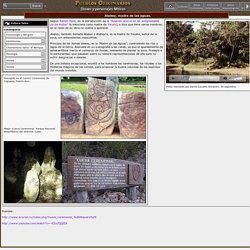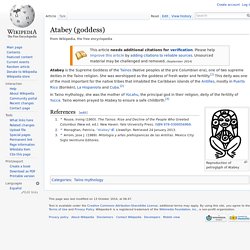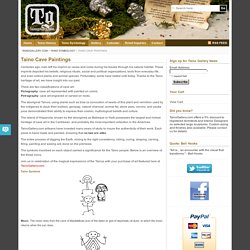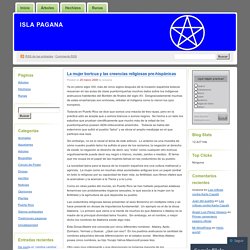Zoom
Trash

Atabey - Atabeira - Atabex. Madre de las aguas. Según Ramón Pané, en la introducción de la "Relación acerca de las antigüedades de los indios" la menciona como madre de Yocahú, y dice que tiene varios nombres; en el resto de su obra no vuelve a aparecer.

Atabey, también llamada Atabex o Atabeyra, es la madre de Yocahú, señor de la yuca, sin antecedentes masculinos. Principio de los demás dioses, es la "Madre de las Aguas", controlando los ríos y lagos de la tierra. Atabey (goddess) Atabey is the Supreme Goddess of the Taínos (Native peoples at the pre Columbian era), one of two supreme deities in the Taíno religion.

She was worshipped as the goddess of fresh water and fertility.[1] This deity was one of the most important for the native tribes that inhabited the Caribbean islands of the Antilles, mostly in Puerto Rico (Borikén), La Hispaniola and Cuba.[2] In Taíno mythology, she was the mother of Yúcahu, the principal god in their religion, deity of the fertility of Yucca. Taíno women prayed to Atabey to ensure a safe childbirth.[3] Ancient Antilles- Myth and Religion. Like many of the people of the ancient Americas, the people of the Antilles believed in a ‘multiverse,’ or multi-leveled universe in which the airy heavens floated above an earth, which itself floated on primordial waters beneath.

Beliefs of this kind could be found from Olmec-era Mesoamerica to the Andes, Amazon and some North American ethnicities. In the Antillean version of the triple world cosmology, the earth was a rough hemisphere, in that it stretched in all directions in a circular manner, but from its disk-like habitable base it undulated with mountains and islands, mounds on the surface of the disk. The earth hemisphere was pocked by caves and sink-holes, sacred entrances to the watery underworld (Siegel in Bercht 97 108; Stevens-Arroyo 2006 183). Above the archipelagic mounds of the earth, was the vault of the dappled heavens, filled with stars, the Milky Way, the moon and the sun, all acting in orderly concert. To the top. Taino Cave Paintings. Centuries ago, man left his imprint on caves and rocks during his travels through his natural habitat.

These imprints depicted his beliefs, religious rituals, social and political organizations, tools from everyday life, and even extinct plants and animal species. Fortunately, some have lasted until today. Thanks to the Taino heritage of art, we have insight into our past. There are two classifications of cave art:Pictography: cave art represented with painted on colors.Petrography: cave art engraved or carved on rocks. The aboriginal Tainos, using plants such as bixa (a concoction of seeds of this plant and vermilion used by the indigenes to daub their bodies), genipap, natural charcoal, animal fat, stone axes, conchs, and yautia juice demonstrated their ability to express their cosmic, mythological beliefs and culture.
TainoGallery.com artisans have invested many years of study to insure the authenticity of their work. Boinayel: God of rain. ShareThis. Atabey on Pinterest. CARRIBEAN FERTILITY MOTHER : ATABEY. Atabeyra. Ateibeyra. Rosario atabey. Atabey. Atabey. Son of Atabey. NUESTRA MADRE TIERRA (MOTHER EARTH, Atabey) Taino Song for Atabey Mother Earth/ Madre Tierra Atabey. Taino Song for Mother Earth. Isla Pagana. Ya en pleno siglo XXI, más de cinco siglos después de la invasión española todavía resuenan en las aulas de clase puertorriqueñas muchos datos sobre los indígenas arahuacos habitantes del Borikén de finales del siglo XV.

Desgraciadamente muchas de estas enseñanzas son erróneas, retratan al indígena como lo vieron los ojos europeos. Todavía en Puerto Rico se dice que somos una mezcla de tres razas, pero en la práctica sólo se acepta que o somos blancos o somos negros. Se hecha a un lado los estudios que prueban científicamente que mucho más de la mitad de los puertorriqueños poseen ADN mitocondrial amerindio. Todavía se habla del exterminio que sufrió el pueblo “taíno” y se obvia el amplio mestizaje en el que participó esa raza.
Sin embargo, no es lo racial el tema de este artículo. La sociedad taína para la época de la invasión española era una cultura matriarcal y agrícola. Esta Diosa-Madre era conocida por cinco diferentes nombres: Atabey, Apito, Zuimaco, Yermao y Guacar.